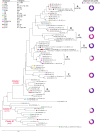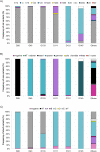Population structure and genetic diversity of non-O157 Shiga toxin-producing Escherichia coli (STEC) clinical isolates from Michigan
- PMID: 33627701
- PMCID: PMC7904848
- DOI: 10.1038/s41598-021-83775-z
Population structure and genetic diversity of non-O157 Shiga toxin-producing Escherichia coli (STEC) clinical isolates from Michigan
Abstract
Non-O157 STEC are increasingly linked to foodborne infections, yet little is known about the diversity and molecular epidemiology across locations. Herein, we used whole genome sequencing to examine genetic variation in 894 isolates collected from Michigan patients between 2001 and 2018. In all, 67 serotypes representing 69 multilocus sequence types were identified. Serotype diversity increased from an average of four (2001-2006) to 17 (2008-2018) serotypes per year. The top six serogroups reported nationally caused > 60% of infections in 16 of the 18 years; serogroups O111 and O45 were associated with hospitalization as were age ≥ 65 years, diarrhea with blood and female sex. Phylogenetic analyses of seven multilocus sequence typing (MLST) loci identified three clades as well as evidence of parallel evolution and recombination. Most (95.5%) isolates belonged to one clade, which could be further differentiated into seven subclades comprising isolates with varying virulence gene profiles and serotypes. No association was observed between specific clades and the epidemiological data, suggesting that serogroup- and serotype-specific associations are more important predictors of disease outcomes than lineages defined by MLST. Molecular epidemiological studies of non-O157 STEC are important to enhance understanding of circulating strain distributions and traits, genetic variation, and factors that may impact disease risk and severity.
Conflict of interest statement
The authors declare no competing interests.
Figures




References
-
- Centers for Disease Control and Prevention. National Shiga toxin-producing Escherichia coli (STEC) Surveillance Annual Report, 2016.https://www.cdc.gov/ecoli/surv2016/index.html (2018).
Publication types
MeSH terms
Substances
Grants and funding
LinkOut - more resources
Full Text Sources
Other Literature Sources

